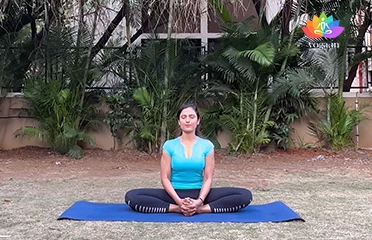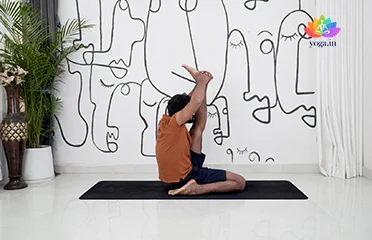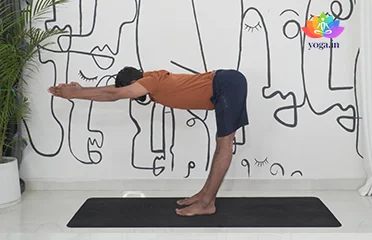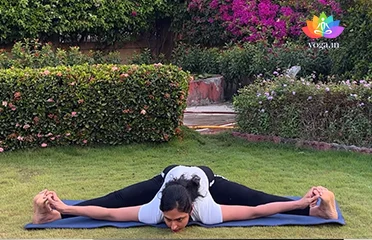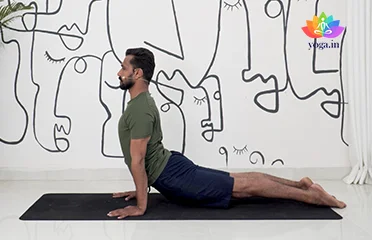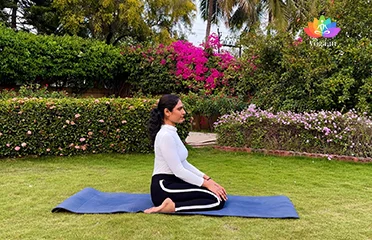Bhadrasana (Gracious Pose | Butterfly Po
भद्रासन / Gracious Pose | Butterfly Pose
The Sanskrit name is derived from Bhadra (भद्रा) meaning gracious, [�K]
Kraunchasana (Heron Pose)
क्रौञ्चासन / Heron Pose
The Sanskrit name is derived from Kraunch (क्रौञ्च) meaning heron [�K]
Pincha Mayurasana (Peacock Feather Pose)
पिंचमयूरासन / Peacock Feather Pose
The Sanskrit name is derived from Pincha (पिंच) meaning feathered, Mayur [�K]
Samakonasana (The Right-Angle Posture)
समकोणासन / The Right-Angle Posture
The Sanskrit name is derived from Sama (समा) meaning straight, Kona meaning [�K]
Upavishta Konasana (Wide-Angled Seated F
उपविष्ट कोनासन / Wide-Angled Seated Forward Bend
The Sanskrit name is derived from Upavistha (उपविष्ट) means open/seated, [�K]
Urdhva Mukha Svanasana (Upward-Facing Do
ऊर्ध्वमुखश्वानासन / Upward-Facing Dog Pose
The Sanskrit name is derived from Urdhva (ऊर्ध्व) meaning up, Mukha [�K]
Virasana (Hero Pose)
वीरासन / Hero Pose
The Sanskrit name is derived from Vira (वीरा) meaning hero or a warrior [�K]
How Yoga Can Help Cure Labour Pain:
Labour pain is the intense discomfort and pain experienced by women during childbirth. Yoga can be a valuable tool in managing and alleviating labour pain by promoting relaxation, enhancing flexibility, and providing techniques for pain management. Through specific yoga postures, breathing exercises, and relaxation techniques, yoga can help create a more comfortable and positive birthing experience.
Understanding Labour Pain:
Labour pain is the pain and discomfort associated with childbirth. It occurs due to the contractions of the uterus as it works to open the cervix and push the baby through the birth canal. Labour pain can vary in intensity and duration and is influenced by factors such as the baby’s position, the mother’s physical condition, and emotional state.
Yoga’s Role in Relieving Labour Pain:
Specific yoga practices can help alleviate the symptoms of labour pain by promoting relaxation, reducing stress, and improving overall physical and emotional well-being. These include gentle yoga postures that enhance flexibility and strength, pranayama (breathing exercises) that help manage pain, and meditation techniques that calm the mind.
Key Factors Contributing to Labour Pain:
Several factors can contribute to the intensity and experience of labour pain, including:
- Baby’s Position: The position of the baby can affect the level of pain experienced.
- Mother’s Physical Condition: A woman’s fitness and health can influence pain levels.
- Emotional State: Anxiety and fear can heighten the perception of pain.
- Duration of Labour: Longer labours can lead to increased fatigue and discomfort.
- Contraction Intensity: Stronger contractions can cause more pain.
Symptoms of Labour Pain:
Common symptoms of labour pain include:
- Intense Uterine Contractions: Painful tightening and relaxation of the uterus.
- Lower Back Pain: Aching or sharp pain in the lower back.
- Pelvic Pressure: A sensation of pressure in the pelvis.
- Cramps: Cramping similar to menstrual pain, but more intense.
- Pain Radiating to Legs: Discomfort spreading from the abdomen to the legs.
Treatment of Labour Pain through Yoga and Pranayama:
Yoga and pranayama can be highly effective in managing labour pain. Some beneficial practices include:
Specific Yoga Poses:
- Baddha Konasana (Butterfly Pose): Opens the hips and reduces pelvic tension.
- Malasana (Garland Pose): Relieves lower back pain and opens the pelvis.
Pranayama Exercises:
- Ujjayi Breath (Victorious Breath): Helps manage pain and maintain focus.
- Deep Breathing: Reduces stress and promotes relaxation.
Diet for Labour Pain:
A balanced diet can support overall health and manage labour pain. Recommendations include:
- Hydration: Drink plenty of water to stay hydrated.
- Complex Carbohydrates: Whole grains, fruits, and vegetables for sustained energy.
- Lean Proteins: Chicken, fish, beans, and nuts to support muscle function.
- Healthy Fats: Avocados, nuts, and olive oil for energy and inflammation reduction.
- Fiber-Rich Foods: To maintain digestive health and prevent constipation.
Caution for Labour Pain:
While practicing yoga for labour pain, it is essential to:
- Avoid Overexertion: Practice at a gentle pace to prevent strain.
- Be Mindful of Pain: Stop immediately if any pose causes discomfort or pain.
Always consult with a healthcare provider before starting any new exercise regimen, especially during pregnancy.
Contraindications for Labour Pain:
Individuals experiencing labour pain should:
- Avoid Intense Yoga Practices: Vigorous exercises might exacerbate symptoms.
- Steer Clear of Certain Poses: Inversions and poses that compress the abdomen may increase discomfort.
- Seek Professional Guidance: Consult a prenatal yoga instructor or healthcare professional for personalized recommendations.


